|
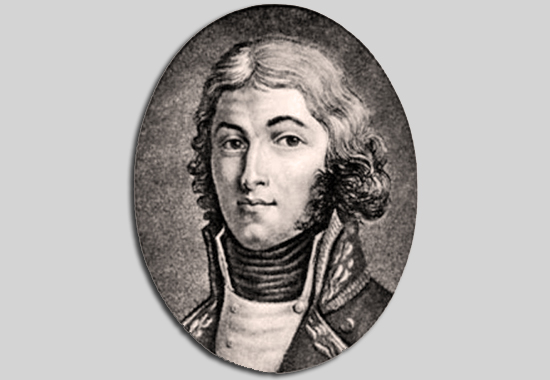
Lazare Hoche 1768-1797
Handsome. Young. Successful. French.
Within a very short life, French
General Lazare Hoche achieved remarkable victories. He died aged 29.
|
|
Image Above
Lazare Hoche
1768-1797
Etching
Bibliothèque Nationale Paris |
Hoche's Character
Hoche was a brave and
decisive military leader.
His pleasant manners and appearance were in balance with a frankness
that underlined his resolution and determination. He treated
others with decency.
In other words, he was the whole
package. And one wonders what he would have accomplished had
he died of old age.
Hoche's Early Years
Louis
Lazare Hoche was born on June 24, 1768,
at Versailles, France. At the time,
Louis XV was the king of France and the map
looked like this:
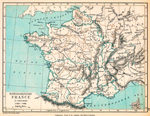
1769 - 1789
France
Lazare's father, a former soldier, was
responsible for the royal hounds in the King's kennels.
His mother died two years after
his birth. He was brought up by his aunt, who earned her
living by selling fruits and vegetables at the market at
Montreuil, on the outskirts of Versailles.
 |
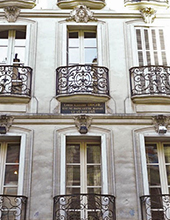 |
 |
Hoche's Birthplace at 18 Rue de
Satory, Versailles, France
Left,
right: Wiki. Center: TopicTopos |
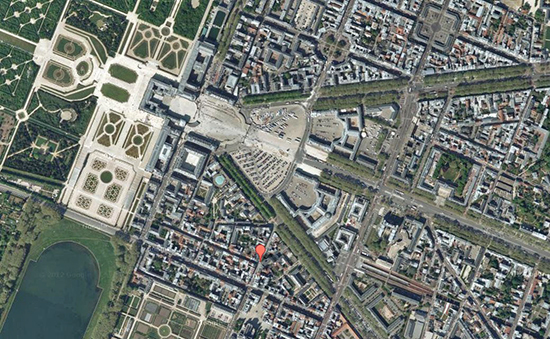
Hoche Sr. Had a Short
Commute. He Lived Just Around the Corner from the Palace.
18 Rue de Satory, Versailles, France (red pin)
Google map
In 1774,
King Louis XV died and his grandson became
 King Louis XVI.
King Louis XVI.
In 1784, young Lazare enlisted with the
French Guards. He was 16 years old.
On July 14, 1789,
the
 French Revolution
broke out.
French Revolution
broke out.
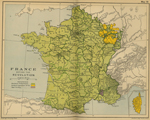
1789 France
Hoche and the War of the First Coalition
The
 War of the First Coalition
(part of the
War of the First Coalition
(part of the
 French Revolutionary Wars)
broke out on April 20, 1792. The war would outlive Hoche by a month. French Revolutionary Wars)
broke out on April 20, 1792. The war would outlive Hoche by a month.
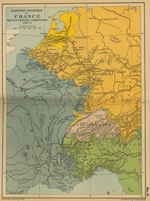
1792-1795 Eastern France
In September 1792,
Hoche was promoted to captain.
Until
October 1793, Hoche fought in the Army of
the North invading the Austrian
Netherlands.

Map of Belgium in 1792
The French
guillotined their king
 Louis XVI
on January 21, 1793.
Louis XVI
on January 21, 1793.
On May 15, 1793, Hoche was promoted
to adjudant-chef de bataillon.
On August 21,
1793, he took Furnes (Veurne) at the
Battle of Furnes.
At the
Siege of Dunkerque
(also Dunkirk), a seaport town fortified by
Vauban
back in the days, Hoche was in charge of the
defense. His superior was French General
Joseph Souham. The Siege of Dunkerque lasted from August 23 to
September 8, 1793. The British besiegers had to
withdraw.
Part of the
British army retreated to Nieuport. On October 24, 1793, the
French began the Siege of Nieuport (Nieuwpoort),
but abandoned the blockade a few days later when
a detachment of Hessians
arrived as reinforcement for the British.
On October 31,
1793, Hoche was promoted to général de division
and put in charge of the
Army of the Moselle.
Incidentally, on October
27, 1793,
Jean-Charles Pichegru was made commander of the
Army of the Rhine.
Hoche was defeated
at the
 Battle of Kaiserslautern
(November 28-30, 1793.)
Battle of Kaiserslautern
(November 28-30, 1793.)
The two generals
Hoche and Pichegru together, but led by Hoche, drove the Austro-Prussian forces from Alsace in
December 1793.
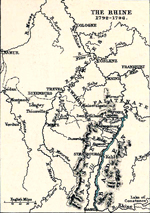
Map of Rhine River and Moselle River 1792-1796
In this campaign's last report, Hoche announced
his wish to resign:
"Now that the goal is reached, I would like
to not have any longer the responsibility of
the command of the Army of the Moselle. The
two together are a burden too heavy for a
head of twenty-six years."
 Jean-Baptiste Jourdan,
former commander of the Army of the North,
became the new commander of the Army of the
Moselle in March 1794.
Jean-Baptiste Jourdan,
former commander of the Army of the North,
became the new commander of the Army of the
Moselle in March 1794.
On March 11, 1794,
Hoche married
Anne Adelaide Dechaux.
The Trap
Hoche's victorious
Rhine campaign had propelled him right into the
crosshair of envy that was maneuvered by
ambitious revolutionaries such as
Saint-Just,
 Robespierre,
and of course Pichegru,
who wrongly claimed to have been the mastermind
behind the campaign. Robespierre,
and of course Pichegru,
who wrongly claimed to have been the mastermind
behind the campaign.
Hoche was well
aware of the fact that a dark cloud was forming over his
head. And it poured down on him as follows:
He received
a communication from the
 Committee of Public Safety informing him that, as a reward for and in
recognition of his outstanding services, he
was given the new assignment to serve in the Army of Italy. He was their person of
choice. It was up to him to accomplish this
difficult task, he, in whom the Committee fully
trusted because he was the most capable person
in the country,
and, in summary, the only one who could do the
job.
Committee of Public Safety informing him that, as a reward for and in
recognition of his outstanding services, he
was given the new assignment to serve in the Army of Italy. He was their person of
choice. It was up to him to accomplish this
difficult task, he, in whom the Committee fully
trusted because he was the most capable person
in the country,
and, in summary, the only one who could do the
job.
Hoche obeyed.
Why?
On August 27,
1793, French Republican
 General Custine had been
guillotined.
General Custine had been
guillotined.
On November 17,
1793, French Republican
General Houchard had
been guillotined.
On December 31,
1793, French Republican
General Biron had been
guillotined.
On January 4,
1794, French Republican
General Luckner had been
guillotined.
These were the days of the
 Reign
of Terror. Reign
of Terror.
And here is more
about the
 guillotine.
guillotine.
Pichegru and Prison
General
Jean-Charles Pichegru accused Hoche of treason. Hoche was arrested on March
21, 1794.
On that day, Hoche
had barely arrived at the headquarters of the Army
of Italy, which were located at Nice, when
General Pierre Jadart
Dumerbion, commander of the Army
of Italy, presented him with a message from the
 Committee of Public Safety advising him that he
was relieved of his duties.
Committee of Public Safety advising him that he
was relieved of his duties.
The arrest order
was signed by
 Lazare
Carnot and
Jean-Marie Collot d'Herbois.
Lazare
Carnot and
Jean-Marie Collot d'Herbois.
As escorted
prisoner, Hoche arrived in Paris on
April 12, 1794, where he was brought before the
Committee of Public Safety. Addressing
Louis de Saint-Just,
Hoche demanded justice, to which Saint-Just dryly replied, "We will give
you very soon the justice that you deserve."
For five weeks,
Hoche was imprisoned at the Carmelite Prison
(Prison des Carmes) at Paris. On May 16, 1794,
he was transferred to the Conciergerie, the only
way out of which was via the scaffold.
Hoche wrote an
appeal to
 Robespierre but the letter wasn't forwarded. Robespierre but the letter wasn't forwarded.
The revolution of
the 9th Thermidor (July 27, 1794) saved Hoche's
neck.
On July 28, 1794,
Maximilien de Robespierre and
Louis de Saint-Just
were guillotined.
Hoche was released
on August 4, 1794.
Lazare and Josephine
 Josephine de Beauharnais,
future wife of
Josephine de Beauharnais,
future wife of
 Napoleon Bonaparte,
was imprisoned at the Prison des Carmes,
a former convent of the Carmelites, from April
20, 1794, until August 6, 1794.
Napoleon Bonaparte,
was imprisoned at the Prison des Carmes,
a former convent of the Carmelites, from April
20, 1794, until August 6, 1794.
Hoche was
imprisoned at the Carmes from April 12, 1794,
until May 16, 1794.
Josephine's
husband, Alexandre de
Beauharnais, lost his head in June
1794.
After her release, Josephine had an affair
with
Paul-François-Jean-Nicolas de Barras,
at the time one of the most powerful men in the
country.
She moved on to
Lazare Hoche until she decided to marry
Bonaparte in March 1796, who was commander of the Army of
Italy at the time.
Hoche and the Wars of the Vendee
Another chapter of
the
 French
Revolutionary Wars were the French
Revolutionary Wars were the
 Wars of the Vendée, a
rebellion that had been costing lives in western France
since February 1793.
General Lazare Hoche would be the man to end these wars.
Wars of the Vendée, a
rebellion that had been costing lives in western France
since February 1793.
General Lazare Hoche would be the man to end these wars.

1793-1796
Brittany and Vendee
In November 1794, Hoche was made
commander of the Army of Brest which was merged with
the Army
of the Coasts of Cherbourg. Hoche found his soldiers in utter
disorder and ill-discipline and had to reorganize the
lot.
The republicans concluded
two peace treaties with the royalist rebels:
On February
17, 1795, the Treaty of
La Jaunaye (Traité de La Jaunaye) was signed by
Charette (François-Athanase
Charette de La Contrie) and other rebel leaders.
On April 9, 1795, the
Treaty of Mabilais
was
signed by the Chouans (named after
the nickname of their leader Jean Cotterreau aka Jean Chouan).
The royalists
accepted the Republic and, in turn, were granted
general amnesty.
At least on paper.
Unrest recommenced and, in addition, the
rebellion got a second wind in June 1795,
when a British fleet arrived at
 Quiberon Bay with
boatloads of French
Quiberon Bay with
boatloads of French
 émigrés
who carried British arms and felt spunky. émigrés
who carried British arms and felt spunky.
The
 Battle of Quiberon
was fought on June 27, 1795.
Battle of Quiberon
was fought on June 27, 1795.

1795 Battle of
Quiberon Bay - June 27
In December 1795, Hoche was made
commander in chief of the
 Army of the Coasts of
the Ocean (L’armée des Côtes de l’Océan).
By July
1796 he had the situation under control.
Army of the Coasts of
the Ocean (L’armée des Côtes de l’Océan).
By July
1796 he had the situation under control.
The
 Wars of the Vendee were over.
Wars of the Vendee were over.
Unlike the last time Hoche had a successful
campaign, this time the
government rewarded Hoche with a real gift — two
fine horses and a select pair of Versailles pistols.

Hoche and the Ireland Expedition
On February 12, 1796, Irish
revolutionary Wolfe Tone
arrived in Paris to promote his idea of a French landing in
Ireland to shake off British rule.
Mutual hatred of the British
prompted the
 Directory to get into bed with Tone. On July
20, 1796, Hoche was put in charge of the expedition. Tone
was made adjutant general.
Directory to get into bed with Tone. On July
20, 1796, Hoche was put in charge of the expedition. Tone
was made adjutant general.
On December 15, 1796, the
expedition sailed
from Brest with an impressive 43 ships and 14,450 troops.
Admiral Bouvet was in
charge of the fleet. General Hoche sailed aboard the Fraternité.
Vicious storms and dense fog ended the expedition. On December 22, 1796,
part of the armada reached Bantry Bay in south-west Ireland
(see map,)
but a landing was out of the question.
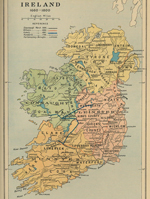
Ireland 1660 -
1800
By January 14, 1797, most ships
were back at Brest. The others didn't make it.
Hoche's Final Year
On February 13,
1797, Hoche left to take his new command of the
Army of the Sambre
and Meuse, thus continuing his fight in the
 War of the First Coalition.
War of the First Coalition.
On April 18, 1797,
Hoch defeated the Austrians, led by
Franz von Werneck, at the
Battle of Neuwied.
In July 1797, the
 Directory
fired its Minister of War,
Claude Louis Petiet,
and named Hoche new head of the department.
However, the post of minister legally required
to be at least 40 years old. Hoche's appointment
had to be revoked.
Directory
fired its Minister of War,
Claude Louis Petiet,
and named Hoche new head of the department.
However, the post of minister legally required
to be at least 40 years old. Hoche's appointment
had to be revoked.
Hoche went back to his army headquarters at Wetzlar
(county of Nassau, today Hesse, Germany) where
he suddenly died on September 19, 1797.
A month later, on October 17,
1797, the War of the First Coalition
ended with the
 Treaty of Campo Formio. Treaty of Campo Formio.

1797
Central Europe
Hoche's Cause of Death
In his
 Mémoires,
the Minister of Police,
Joseph Fouché, is convinced that it
was poison that ended Lazare Hoche's life.
Mémoires,
the Minister of Police,
Joseph Fouché, is convinced that it
was poison that ended Lazare Hoche's life.
In his Lazare
Hoche biography, Emile de Bonnechose
notes that an autopsy
had been inconclusive:
His body was opened
and in his stomach was found residue of what
could have been poison, enough perhaps to
legitimize the suspicions, but not enough to
confirm them.
Hoche might have died of pneumonia.
In his Diary,
Wolfe Tone wrote on September 13, 1797, that Hoche
has been very
ill with a violent cold and has still a
cough, which makes me seriously uneasy about
him;
[...] he is
dreadfully altered and has a dry hollow
cough that it is distressing to the last
degree to hear him. I should be sincerely
and truly sorry if anything were to happen
him, but I very much fear he will scarcely
throw off his present illness.
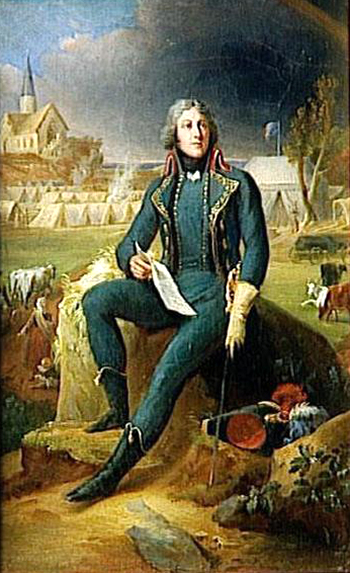
Louis-Lazare Hoche
Oil on canvas by
François Gerard, 1836
Versailles
More History
|